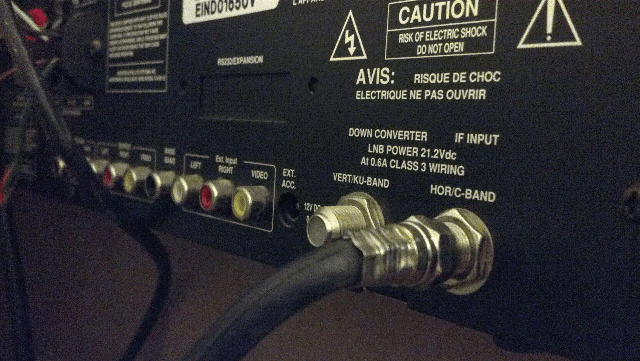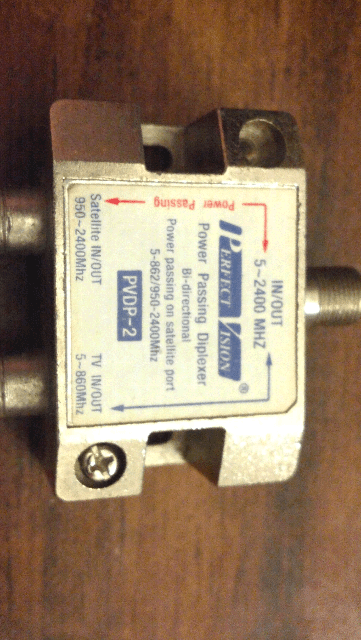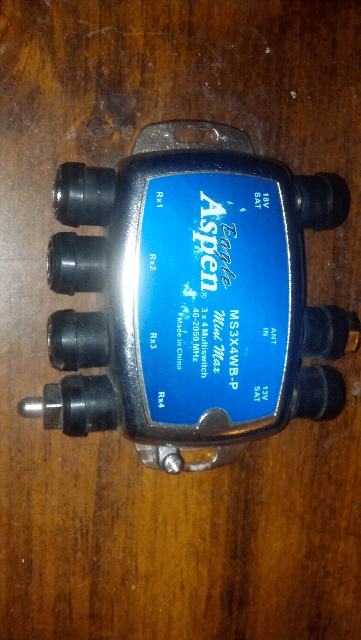Rookie
- Thread starter sathunt
- Start date
- Latest activity Latest activity:
- Replies 92
- Views 17K
You are using an out of date browser. It may not display this or other websites correctly.
You should upgrade or use an alternative browser.
You should upgrade or use an alternative browser.
- Status
- Please reply by conversation.
Tried adjusting dish up and down a small amount at a time. I did notice a difference in signal strength, but it still didn't pick up any new channels. (Still at 99w) the Fox feed only comes in a couple times a day, and it doesn't even show up on the Lyngsat chart. It was also trying to pull in a few radio stations after moving but never got any sound. There aren't any radio stations listed on Lyngsat for 99w either. I even went into Transponder list on microHD menu and tried manually entering and searching a specific TP, still no luck. Pretty much back at square one as to where to proceed fro, here. And the reason I keep trying 99w is its the only one I've had any kind of luck w/.
How are you controlling the polarity of your Feedhorn? I believe that is is currently incorrect and only providing one polarity, not both. It probably isn't optimized either.
Leave your analog receiver connected to the actuator and polarity servo and set the skew to 90. Look inside the Feedhorn. Is the probe rotated to an approximate skew for 99.2w?
Connect the coax directly from the LNB to yhe microHD. Set the microHD Switch / Motor Setting menu to 99.2w C G16, LO 5150, Preprogrammed TP 4000 (polarity: Horizontal Symbol Rate: 26400). This is the strongest transponder on 97w.
Any Signal Quality reading? If not, first adjust the skew then bump East/West using the analog receiver while watching the Signal Quality reading. Peak the Signal Quality reading.
Once you have a Signal Quality reading, exit screen and enter the Single Satellite Search menu screen. Change the polarity to Horizontal, select type to Blind Scan and start the scan Leave the other settings at default.
In a few minutes you will have logged all Horizontal channels. Once you get this far, check back on and we will walk you through logging and watching the Vertical channels.
Good Luck!
Leave your analog receiver connected to the actuator and polarity servo and set the skew to 90. Look inside the Feedhorn. Is the probe rotated to an approximate skew for 99.2w?
Connect the coax directly from the LNB to yhe microHD. Set the microHD Switch / Motor Setting menu to 99.2w C G16, LO 5150, Preprogrammed TP 4000 (polarity: Horizontal Symbol Rate: 26400). This is the strongest transponder on 97w.
Any Signal Quality reading? If not, first adjust the skew then bump East/West using the analog receiver while watching the Signal Quality reading. Peak the Signal Quality reading.
Once you have a Signal Quality reading, exit screen and enter the Single Satellite Search menu screen. Change the polarity to Horizontal, select type to Blind Scan and start the scan Leave the other settings at default.
In a few minutes you will have logged all Horizontal channels. Once you get this far, check back on and we will walk you through logging and watching the Vertical channels.
Good Luck!
Controlling polarity through analog receiver. Thanks for input, very detailed on what to do. Unfortunately I didn't get any results. That Transponder wasn't pre programmed at 99.2w but I went in and added it. Still no results. Adjusted east and west, north and south. Nothing. When setting polarity at 90, inside it was aligned with top support arm. Tried adjusting polarity each time I moved dish, didn't make any differnce on meters. I have been moving, adjusting and scanning for about 5 hours today and haven't hit any signals. B4 I changed lnb I had picked up all remaining analog channels on old receiver and lnb. So I couldn't be that far off the stationary belt to have picked them all up, correct?
Skew is a fixed setting. You sent the Horizontal, then Vertical, and should not have to change it.
With the dish aimed straight south, the probe in the feed will be vertical, for vertical transponders, and horizontal for, you guessed it, horizontal transponders.
You'll have to scan one polarity at a time because your analog receiver is controlling the servo, that drives the probe.
I.E. select a even channel on the analog, scan with FTA STB. Scan again with an Odd channel selected on the analog receiver.
(An LNBF would make it automatic, polarity selected by the FTA LNBF voltage)
You'll have to scan one polarity at a time because your analog receiver is controlling the servo, that drives the probe.
I.E. select a even channel on the analog, scan with FTA STB. Scan again with an Odd channel selected on the analog receiver.
(An LNBF would make it automatic, polarity selected by the FTA LNBF voltage)
When u say skew. Do u mean that the probe inside feedhorn needs to be pointed at satellite? And the probe is rotated when im controlling polarity?
Correct. When you change between an odd and even channel using the analog receiver, the mechanical servo rotates the probe inside of feedhorn. The skew adjustment fine tunes the rotation of the polarity switching. When the dish is aimed to true south (the highest point of the arc), the probe will be straight up and down (12 o'clock position) when a vertical transponder is selected and rotated 90 degrees to the 3 o'clock position when tuned to a horizontal polarity transponder.
On 99w transponder frequency 4000 has a Horizontal polarity with a symbol rate of 26400. This means that the probe will be rotated to a horizontal position. 99w satellite is west of your location. So if you reference this Satellite Aiming Calculation from www.GeoSatFinder.com, you will note that the LNBF will not be physically pointed at the 3 o'clock position. When the dish is pointed at 99w, look into the feedhorn and the probe will be pointed at approximately the 4'oclock position.
Here is the theory... With the dish aimed due south at the highest point of the arc, the Vertical probe will be pointed straight up = 0 degrees. As the dish moves on the polar mount, the feedhorn rotates . When your dish is pointed to the west of the top of the arc at 99w, the vertical channel skew will be rotated by approximately 25 degrees. From your location looking west at the 99w satellite, a vertical transponder will actually be viewed at a +25 degrees with no adjustment of the polarization or skew setting on the analog receiver.
Now select a Horizontal polarity channel on the analog receiver. The servo will rotate the probe 90 degrees. When you look inside the feedhorn, you will see the probe appears to be oriented 90 + 25 = 115 degrees from a vertical plane. The right side of the probe will be lower than the left side. This is a positive 25 degree skew setting.
Now you say, "what a hassle just to change between the two polarities", and you are correct. This is why many dish owners have removed the Feedhorn/LNB configuration like your system has and replaced with a LNBF that automatically electronically switches between Horizontal and Vertical polarity with DVBS S2 receivers. Your current Feedhorn/LNB has better performance, but more of a hassle to use the analog receiver to select the correct polarity for the tuned channel.
Last edited:
Thank you for spending so much time explaining all this. This is why I bought American! One more question for now. According to my analog receiver the mid way point of my motor is between W1 east, and Anik E1 west. W/ Spacenet4, Galaxy4 being east of W1. & Anik E2, Telstar3 being west of E1. I've never ben able to come up w/ what an exact center would be bcus all have moved. My best guess being somewhere in the 110w range. What im calling/guessing is 99w is about half way between what should b center and my east limit. You can make sense of all that can you maybe give me an idea of where my center may be. And the reason I ask, are there any other satellites that you would recommend trying to lock that would be better easier than 99w?
Your true south satellite matches your longitude. In Virginia this would be near 77w. The compass reading would be approximately 190.
Might be easier to drive your dish to a position near the top of your arc as signals are easier to find on satellites near the center. Look at the way the dish aligns with the mount. The mechanics of the mount should line up when the dish is lined up with the top of the arc.
Try satellite SES2 at 87w. An easy to lock transponder is 4154, Horizontal, 19532. With the dish centered and the probe polarity set to horizontal, slowly bump the dish west while observing the Signal Quality meter reading. SES2 satellite is approx 15 degrees west at compass reading 205.
Might be easier to drive your dish to a position near the top of your arc as signals are easier to find on satellites near the center. Look at the way the dish aligns with the mount. The mechanics of the mount should line up when the dish is lined up with the top of the arc.
Try satellite SES2 at 87w. An easy to lock transponder is 4154, Horizontal, 19532. With the dish centered and the probe polarity set to horizontal, slowly bump the dish west while observing the Signal Quality meter reading. SES2 satellite is approx 15 degrees west at compass reading 205.
For any1 who doesn't already know, Brian at SatellitAV, is THE MAN! MicroHD was power cycling. Called Brian and he walked me through exactly what to do. Had a little trouble updating via TTL header, as I am not a computer whiz. But looking back, it wasn't really all that difficult. Glad I bought from them. Now I have a new problem. I'm having trouble locating satellites on old receiver. Have multiple hits ranging from 87w to 121w. Only a couple satellites I can verify being some of the channels I've scanned are not on Lyngsat, so I'm not sure what satellite I'm on. The main question I have is, why isn't MicroHD logging all the TPs on the satellites I have verified? And the pattern I've noticed on all the scans, is the only TPs I'm logging are ABOVE 4000mhz. Is there something on BUD that needs tweaking? Any suggestions?
Thank you for your most kind words! Our team is here to support!
How is the LNB powered? The LNB may require 18vdc at all times to work properly. If powered by the microHD, a vertical scan will output 13vdc. This might not be enough power for the LNB. I would suggest that the LNB be powered by the analog receiver and use a high frequency splitter (one port power passing) to feed the lnb output to both the analog (powered side) and microHD.
Is the polarity being switched using the old analog receiver? It will take two blind scans with a LNB set-up like yours. One for vertical transponders and once again for horizontal. If powering the LNB with the microHD, try leaving the polarity setting to Horizontal even for the vertical scans to provide 18vdc to the electronics.
What LO frequency is selected in the microHD?
Are the blindscan default frequencies left at the default settings?
How is the LNB powered? The LNB may require 18vdc at all times to work properly. If powered by the microHD, a vertical scan will output 13vdc. This might not be enough power for the LNB. I would suggest that the LNB be powered by the analog receiver and use a high frequency splitter (one port power passing) to feed the lnb output to both the analog (powered side) and microHD.
Is the polarity being switched using the old analog receiver? It will take two blind scans with a LNB set-up like yours. One for vertical transponders and once again for horizontal. If powering the LNB with the microHD, try leaving the polarity setting to Horizontal even for the vertical scans to provide 18vdc to the electronics.
What LO frequency is selected in the microHD?
Are the blindscan default frequencies left at the default settings?
Lnb is currently being powered through microhd. I have tried numerous blind scans at different polarities on each satellite. Adjusting about 10degrees each time. I've had the most luck around 60 and -30 degrees. I have a splitter that goes up to 2400mhz. Will that suffice? And looking at the back of analog receiver, it says lnb power is 21volts. Will that make a difference? Do I need to connect only to c band connection on analog, or both? And yes, all settings were left at default when doing blind scans.
Attachments
A splitter with frequency 2400mhz or above is good. Connect the power passing port to the C-band port of the analog receiver and the non-power passing port to the microHD. Switch polarity by switching the analog receiver between the two channels (1 to 2, etc).
The 21vdc is fine. LNBs work best if powered with 18+ volts.
Life would be much easier if the feed horn/LNB were changed to a LNBF like posted earlier. Too much work to control polarity with the old receiver.
The 21vdc is fine. LNBs work best if powered with 18+ volts.
Life would be much easier if the feed horn/LNB were changed to a LNBF like posted earlier. Too much work to control polarity with the old receiver.
Analog connects to power pass side, Microhd to the other, coax from satellite to single connection on top?
Hi sathunt. Welcome to our forum. i have been loosely following your thread. sorry to hear you're not getting all the channels you should. I think I know why. Hopefully my explanation is not too long winded for you. the picture you have in post # 54 (this is why good members like Anole always insist on pictures) is of a unit called a "diplexer". It is NOT a splitter. A "diplexer" is used to combine the signal from a satellite dish and a TV antenna like your UHF/VHF unit. You want a unit called a splitter which combines the signal from one satellite dish to two satellite receivers. the second port on the diplexer only works well up to to 860MHZ (like what TV antennas use) not the 2000MHZ needed for satellite dishes. And you can't just switch the old analog receiver from port one to port two and the microhd from port two to port one since the analog receiver has to be on the power pass port one to power the lnb. So I think you will need to purchase a splitter not a diplexer. Splitters are fairly inexpensive. Brian at SatAV has them here http://www.satelliteav.com/p/shop/?ws_pid=645&ws_cat=429.
Hope this helps.
Kevin
Thanks beavs. You guys are beyond freaking awesome! And yes Brian, this is a huge pain in my rear controlling polarity like this. Will probably soon be looking into switching to a lnb/feedhorn combo. Wanted to convince the wife it would actually work before putting more $ into it tho. She said something last night about buying one for my birthday  , which is coming up soon. I have a great, understanding wife
, which is coming up soon. I have a great, understanding wife  . So would this splitter work? I would need a dc blocker for microhd side wouldn't I?
. So would this splitter work? I would need a dc blocker for microhd side wouldn't I?
Attachments
That is not a splitter. It is a multi-switch and will not work for this application.
Check out: https://www.satelliteav.com/p/shop/?ws_pid=645&ws_cat=429
BTW... Kevin, great catch on the diplexer!
Check out: https://www.satelliteav.com/p/shop/?ws_pid=645&ws_cat=429
BTW... Kevin, great catch on the diplexer!
Last edited:
Something like this should work.
Found it at Lowes hardware. http://www.lowes.com/pd_251903-1270...l=1¤tURL=?Ntt=cable+splitter&facetInfo=
Found it at Lowes hardware. http://www.lowes.com/pd_251903-1270...l=1¤tURL=?Ntt=cable+splitter&facetInfo=
- Status
- Please reply by conversation.
Similar threads
- Replies
- 7
- Views
- 1K
Users Who Are Viewing This Thread (Total: 0, Members: 0, Guests: 0)
Who Read This Thread (Total Members: 1)
Latest posts
-
B
-
H
-
-




